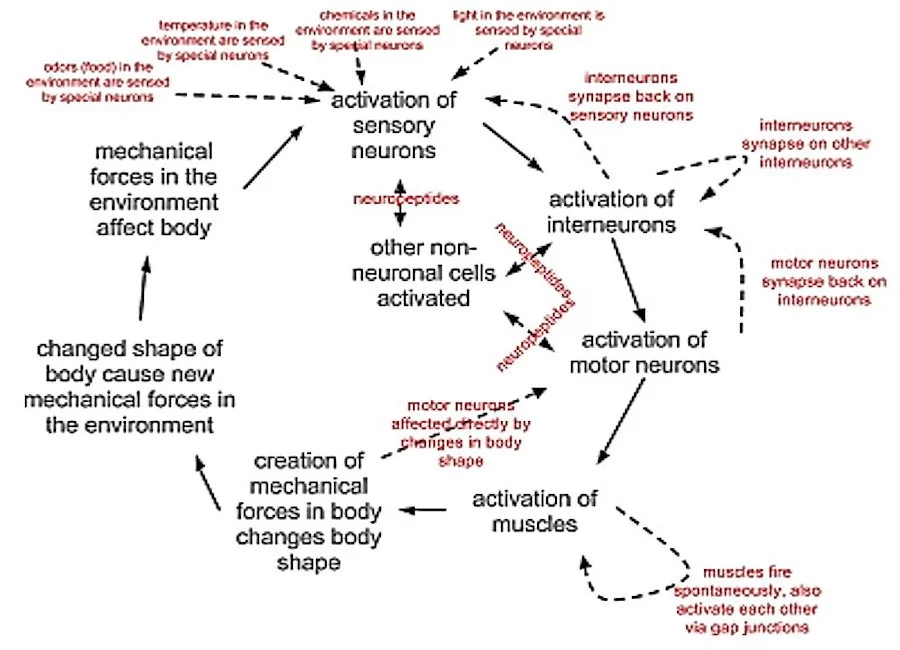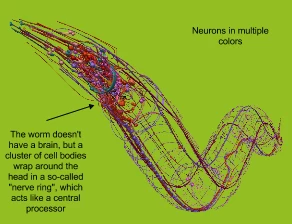The OpenWorm project is aimed at creating the first artificial lifeform – a bottom-up computer model of a millimeter-sized nemotode, one of the simplest known multicellular organisms. In an important step forward, OpenWorm researchers have completed the simulation of the nematode's 302 neurons and 95 muscle cells and their worm is wriggling around in fine form.
The C. elegans nemotode is one of the simplest multicellular organisms known. Its hermaphroditic form has only 959 cells, of which 302 are neurons. Despite this simplicity, the nematode is equal to the usual challenges of living, such as feeding, reproducing, and avoiding being eaten.
To model the complex behavior of this organism, the OpenWorm collaboration, begun in May 2013, is developing a bottom-up description. This involves making models of the individual C. elegans cells and their interactions, based on their observed functionality in the real-world nematodes. Their hope is that realistic behavior will emerge if the individual cells act on each other as they do in the real organism. artificial animal

At present, input-output models for the individual cells are being used. For example, the model of a muscle cell says "I am such a size and shape when relaxed, and the mechanical properties of my membrane and innards are such and such. I'm connected to the following list of cells through contact with certain portions of my cell membranes. Six neurons make contact with my structure, which produce the following list of behaviors when stimulated. My passive and active responses to cells surrounding me make up my model."
This approach is intended to see if both the homeostatic and dynamic behaviors of the nematode can be modeled without requiring a complete description of the underlying chemical reactions.

The simulated nematode is being built of code packages corresponding to the various types of cells and interconnections found in a real C. elegans. Fortunately, we know a lot about these nematodes. The complete cellular structure is known, as well as rather comprehensive information concerning the behavior of a real C. elegans in reaction to its environment. Included in our knowledge is the complete connectome, a comprehensive map of neural connections (synapses) in the worm's nervous system.
At present, the model has grown to include the 302 neurons of the nervous system and the complete set of 95 muscle cells. When simulated inputs are delivered to the nervous system, the simulated nematode performs a highly realistic swimming motion (see video below).
Assuming that the behavior of the simulated C. elegans continues to agree with the real animal, at what stage might it be reasonable to call it a (very simple) living organism? The usual definition of living organisms is behavioral; they extract usable energy from their environment, maintain homeostasis, possess a capacity to grow, respond to stimuli, reproduce and, through natural selection, adapt to their environment in successive generations. If the simulation exhibits these behaviors, combined with realistic responses to its external environment, should we consider it to be alive?
One might argue for an altered version of the Turing test. In the Turing test, a computer is considered sentient and sapient if it can simulate the responses of a conscious sentient being so that well prepared and suspicious auditors cannot tell it isn't a person. The modified Turing test for life might say that a simulated organism is alive if a skeptical biologist cannot, after thorough study of the simulation, identify a behavior (or lack thereof) that argues against the organism being alive. As in the traditional Turing test, behavior that seems appropriate for a living being is considered strong evidence that the organism is, in fact, alive.
On the other hand, this criterion feels too easy to meet, suggesting that I at least have a number of basic prejudices about what life is. This, of course, was the purpose of the Turing test, to eliminate such prejudices by filtering the interaction through a machine (originally a teletype). So is something alive if it behaves alive? If not, why? If we made a nematode by putting a batch of artificial, but physical, cells together in the right order, would it be alive?
As humanity is traveling along various paths that seems on the verge of creating "artificial life" from several directions, it is probably time that we figure out how to differentiate the living from the nonliving. Structure? Behavior? DNA? Local reduction of entropy? Fortunately, this is a question whose answer is above my pay grade.
The following video shows the simulated worm strutting its stuff.
Source: OpenWorm




